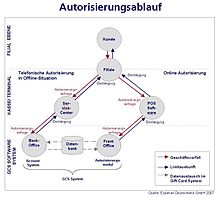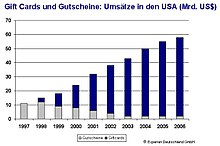gift card
A gift card , as a gift card , electronic gift card or as a shopping card called, is a special form of credit card that is used in retail. Gift cards are designed as a replacement for paper vouchers. If these are issued online as PDF, they are called eGiftCard .
function
The cards are almost always in the form of a payment or credit card . The voucher card is not issued in the name of a person, but is marked with a unique number and can be used by any holder. The number can be read using a barcode , magnetic strip or an RFID chip. Like other prepaid cards, gift cards can be topped up by depositing certain amounts. The voucher cards entitle the respective holder to make purchases from the acceptance partner (usually the branches of a retail chain) up to the amount booked on the card.
System description
Gift cards are part of a system for electronic voucher processing. The system consists of the voucher cards themselves and the authorization and account system. The gift card transactions are usually authorized online against a central server.
The processing of gift cards takes place via online authorization. For this purpose, the transaction data is sent in real time from the point of sale to a central server. The unique gift card account is recognized there and the account balance is changed according to the type of transaction. All sales locations in a system group have online access to this data. The different transactions are essentially:
- Top-up: Acquisition of the card or initial credit transfer to the card account at the point of sale
- Unloading: Purchasing with the card, settlement of the purchase amount and corresponding adjustment of the card's account balance
- Reload: Repayment of credit to the card account
- Credit check: The customer has the option of checking the balance of his card either on site at the point of sale via the internet or via a hotline
- Cancellation: topping up and unloading the card can usually be canceled on a daily basis at the point of sale
Market situation
There are currently three different models in the gift card market:
The classic variant is called a closed-loop system . Here the customer purchases a gift card issued by the retail trade, which can only be redeemed in the branches of the respective retail company.
In contrast to this, an open-loop system is a network of different participants. Open-loop systems are often mapped using existing credit card systems such as American Express , Visa or Mastercard . In this case, a large number of acceptance points can be used worldwide. In this type of credit card-based systems, an activation and / or processing fee is often charged.
The third model is the semi or hybrid open loop system . A point of sale offers cards from various closed-loop systems. Examples of this can be found in the form of so-called gift card malls and gift card shops . These models are already widespread in the Anglo-American market. In Germany, the model was introduced by Retailo AG in 2008 .
While the market for paper vouchers in Germany has stagnated for years, the gift card has seen a sharp increase in sales since its introduction on the US market. In 1998, a year after its introduction, sales of gift cards generated nearly $ 3 billion in revenue. In 2003 sales rose to just under 40 billion US dollars.
Gift cards as collectibles
Gift cards have now become a popular collector's item . They have a handy format and customers are usually allowed to keep the cards after redeeming the credit. In addition, some companies started to publish various motifs to honor seasonal occasions. Increased demand from collectors led some companies to discover collectors as a target group and created an appealing design for the cards . There are now cards in a non-rectangular shape or with special image effects (for example, picture cards from Galeria Kaufhof ). In Germany, large retail chains such as Thalia publish cards with city motifs from the cities of their branches. The Media-Saturn-Holding GmbH has a total of 1,766 worldwide (as of 2013) published various motives.
An online catalog can be found on Colnect. A large part of the gift card collectors had previously specialized in telephone cards .
For companies, the gift card is, on the one hand, an advertising medium and , on the other hand, it creates customer loyalty , as collectors often buy cards with credit to get the relevant motif. Well-designed motifs can also lead to word of mouth .
eGiftCard
eGiftCards are trade vouchers that can be printed out and redeemed in the branches of the respective retailer. Also known as voucher for self-printing, PDF voucher or gift card for self-printing.
Use and acceptance
The consumer usually buys the eGiftCard in the retailer's online shop and prints it out by email upon receipt. This printout is usually given away as a gift and can then be used in the retailer's branches and sometimes also in the online shop. According to a 2011 study by FirstData of 2,100 US citizens, 12% have already bought an eGiftCard and 14% have received an eGiftCard. 48% of the respondents would be interested in receiving an eGiftCard. If an eGiftCard has already been received, 43% of it was redeemed in stores and 33% in the online shop (100% missing: No answer / don't know).
literature
- David Cavell: The Prepaid Cards Revolution . VRL Publishing Ltd, UK 09/2005, ISBN 1-905457-07-3 .
- Volker Patzak: More than a gift . In: retail technology . No. 4, 2006.
- Datamonitor (Ed.): Payment cards in Germany 2006 . 1st edition. London / UK 09/2006, DMFS1941.
- MasterCard Worldwide (Ed.): Prepaid card payments are expected to reach $ 164 billion in Europe by 2010 . Prague / Frankfurt May 2007.
- Konrad, Jörg: Rewe promotes the desire to give . In: Lebensmittel Zeitung . No. 31, 2007.
Individual evidence
- ^ Welt am Sonntag , October 11, 2009: Big deal with the voucher
- ↑ Study by First Data Corporation (PDF; 2.0 MB)
Web links
- Legal consideration of gift vouchers (eKritik)

